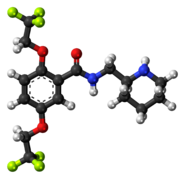Flecainide
 |
|
 |
|
| Clinical data | |
|---|---|
| Trade names | Tambocor |
| AHFS/Drugs.com | Monograph |
| MedlinePlus | a608040 |
| Pregnancy category |
|
| ATC code | |
| Pharmacokinetic data | |
| Bioavailability | 95% |
| Protein binding | 40% |
| Metabolism | CYP2D6 (limited) |
| Biological half-life | 20 hours (range 12–27 hours) |
| Excretion | Renal |
| Identifiers | |
|
|
| CAS Number | |
| PubChem CID | |
| IUPHAR/BPS | |
| DrugBank | |
| ChemSpider | |
| UNII | |
| KEGG | |
| ChEBI | |
| ChEMBL | |
| ECHA InfoCard | 100.211.334 |
| Chemical and physical data | |
| Formula | C17H20F6N2O3 |
| Molar mass | 414.343 g/mol |
| 3D model (Jmol) | |
| Chirality | Racemic mixture |
|
|
|
|
|
|
|
Flecainide acetate (/flɛˈkeɪnaɪd/ flek-AY-nyde) is a class Ic antiarrhythmic agent used to prevent and treat tachyarrhythmias (abnormal fast rhythms of the heart). It is used to treat a variety of cardiac arrhythmias including paroxysmal atrial fibrillation (episodic irregular heartbeat originating in the upper chamber of the heart), paroxysmal supraventricular tachycardia (episodic rapid but regular heartbeat originating in the atrium), and ventricular tachycardia (rapid rhythms of the lower chambers of the heart). Flecainide works by regulating the flow of sodium in the heart, causing prolongation of the cardiac action potential.
Flecainide is sold under the trade name Tambocor (manufactured by 3M pharmaceuticals). Flecainide went off-patent on February 10, 2004. In addition to being marketed as Tambocor, it is also available in generic version and under the trade names Almarytm, Apocard, Ecrinal, and Flécaine.
Flecainide is used in the treatment of many types of supraventricular tachycardias, including AV nodal re-entrant tachycardia (AVNRT) and Wolff-Parkinson-White syndrome (WPW). This is because of the action of flecainide on the His-Purkinje system.
...
Wikipedia
